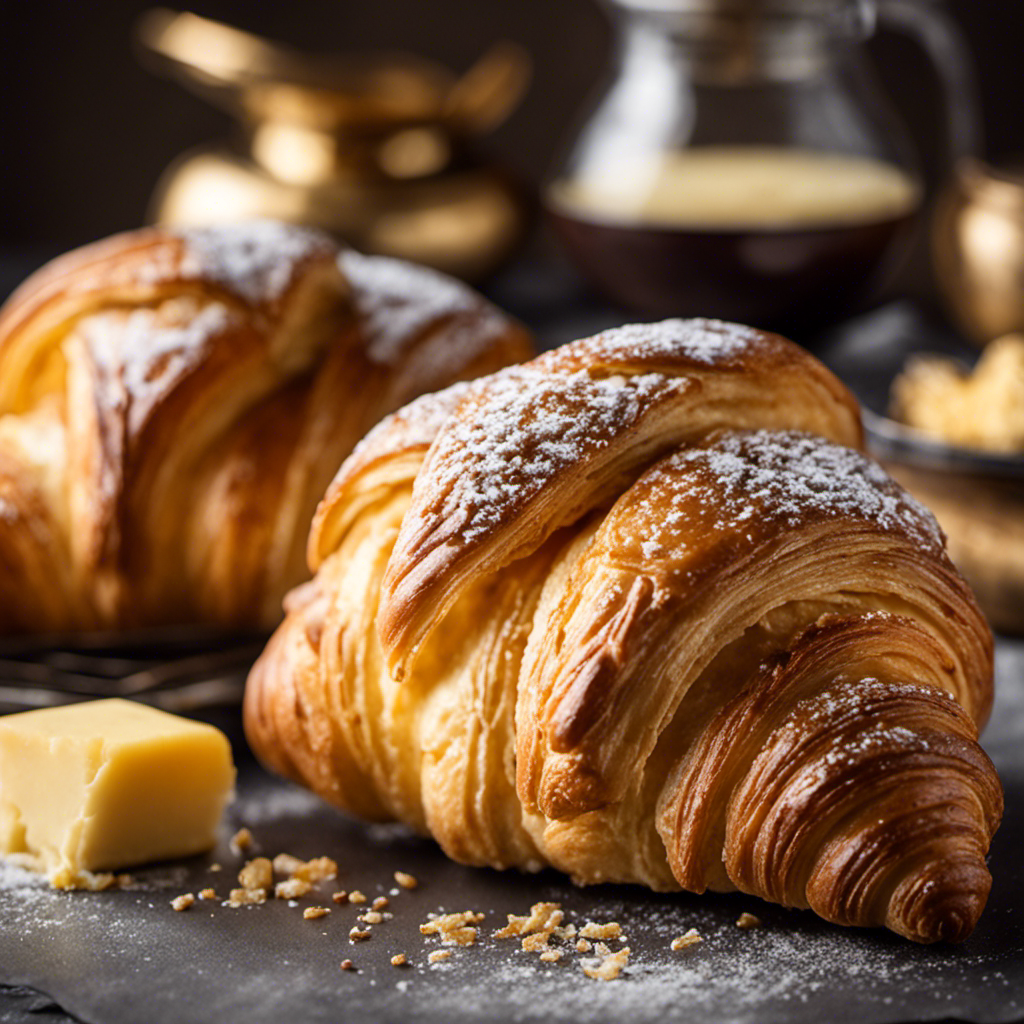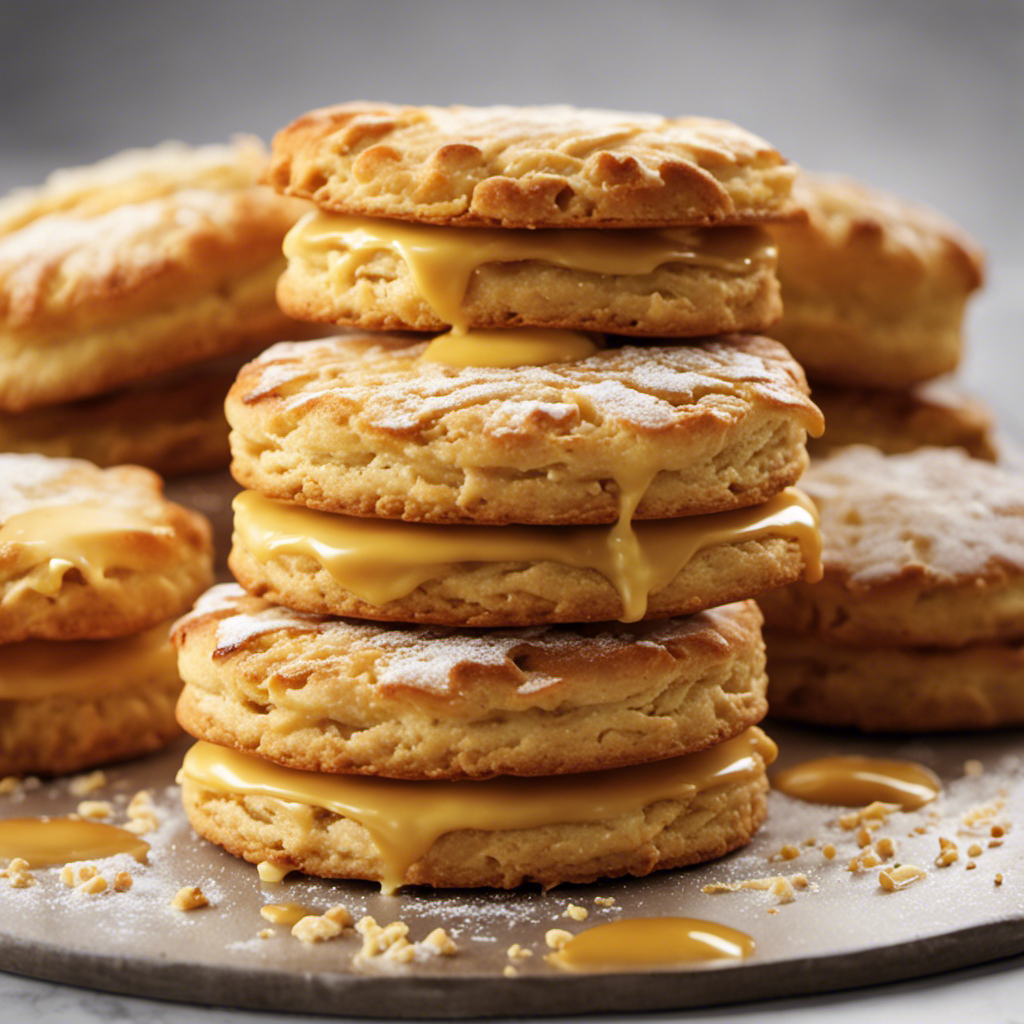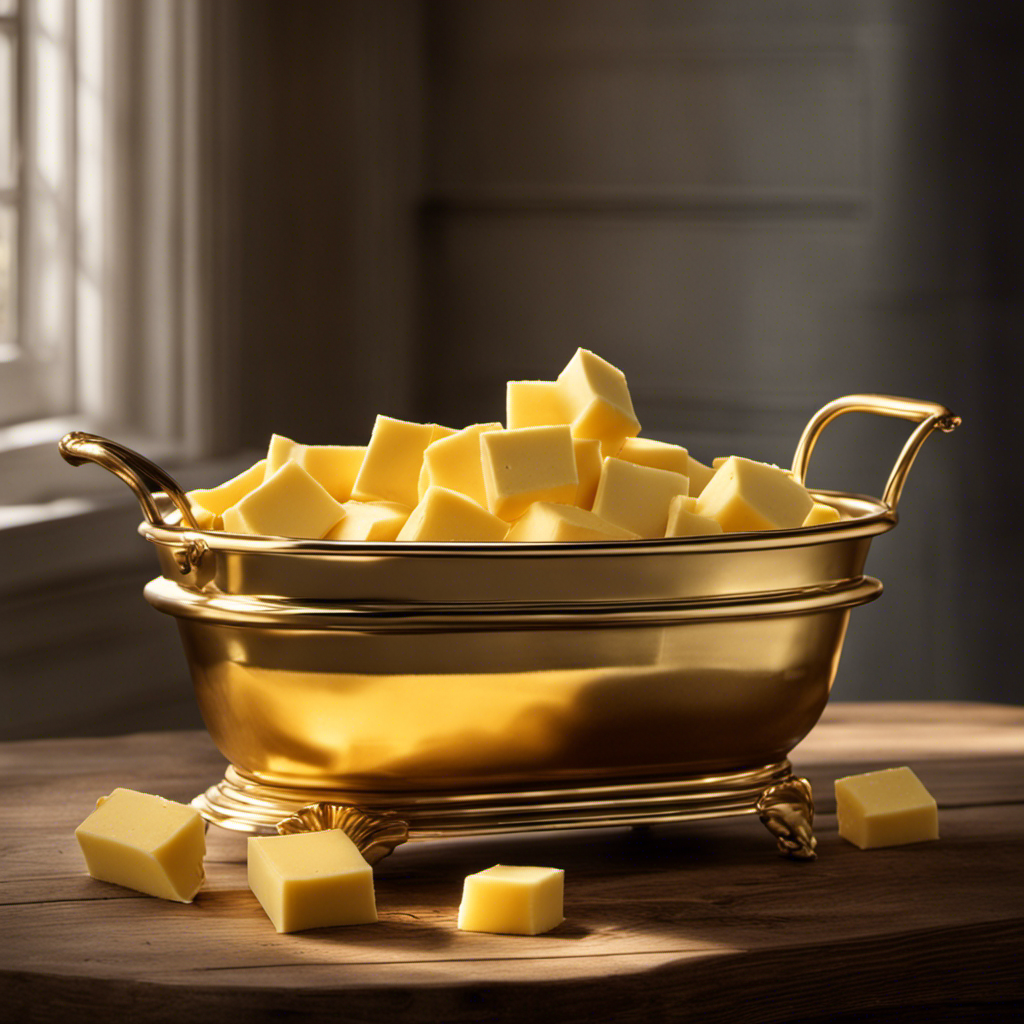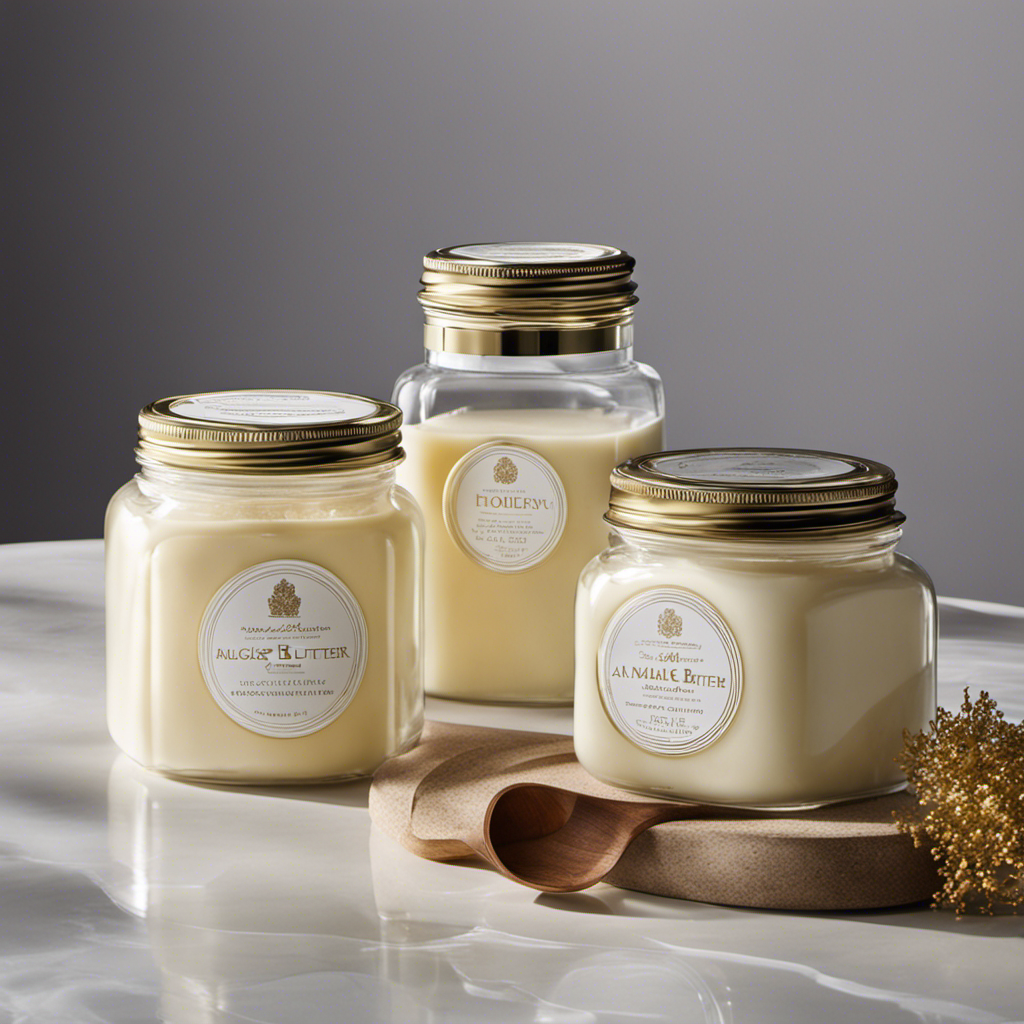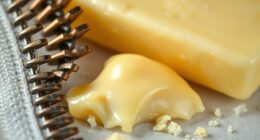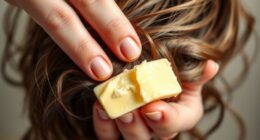I have always been fascinated by the role of butter in baking. It is amazing to witness how this simple ingredient can truly transform a recipe.
In this article, we’ll dive into the technical aspects of butter in baking. From its function as a fat source to its impact on texture, flavor, and moisture, we’ll explore how butter contributes to the deliciousness of baked goods.
Join me as we unravel the mysteries behind butter’s influence on leavening, creating layers, and binding ingredients in the world of baking.
Key Takeaways
- Butter adds richness and flavor to baked goods.
- Butter contributes to a smooth and cohesive texture in baked goods.
- Butter enhances browning and adds depth of flavor.
- Butter helps in creating a tender and moist texture in baked goods.
The Role of Butter in Baking
Butter adds richness and flavor to your baked goods, making them moist and delicious. In addition to enhancing taste, butter also plays a crucial role in emulsification.
Emulsification is the process of combining two liquids that would not normally mix, such as oil and water. Butter contains both water and fat, allowing it to act as a bridge between these two substances. This helps create a smooth and cohesive texture in your baked goods, resulting in a more tender and uniform crumb.
Furthermore, butter’s high fat content contributes to the browning process. When exposed to heat, the milk solids in butter undergo a Maillard reaction, producing a rich golden brown color and a distinct flavor. This browning effect adds depth and complexity to your baked creations.
As we delve further into the topic, we will explore butter as a fat source in baking.
Butter as a Fat Source in Baking
Margarine is often used as a substitute for butter in baking due to its similar fat content and consistency. However, it is important to understand the role of butterfat in baking and the different types of butter that can be used.
Butterfat plays a crucial role in baking, providing moisture, flavor, and richness to baked goods. It helps in creating a tender and moist texture while adding a distinct buttery flavor. The fat content in butter also helps in trapping air during the creaming process, resulting in a lighter and fluffier texture.
When it comes to different types of butter, there are several options available. The table below provides a comparison of some common types of butter used in baking:
| Type of Butter | Fat Content (%) | Water Content (%) | Ideal for |
|---|---|---|---|
| Unsalted Butter | 82-86% | 14-18% | General baking |
| Salted Butter | 80% | 15-18% | Everyday baking |
| Clarified Butter | 99-100% | 0% | High-heat baking |
| European-style Butter | 82-86% | 14-18% | Pastry and croissant making |
Understanding the role of butterfat and choosing the right type of butter can greatly impact the texture, flavor, and overall success of your baked goods. So next time you’re baking, consider the options and make an informed decision!
Butter’s Impact on Texture in Baking
When it comes to baking, butter plays a crucial role in achieving the desired tenderness of the final product. As a fat source, butter coats the flour particles and inhibits gluten development, resulting in a tender texture.
Moreover, butter’s high fat content also contributes to the moisture in baked goods, leading to a softer and moister end result.
Butter’s Role in Tenderness
To achieve optimal tenderness in your baked goods, you’ll want to make sure you’re using the right type of fat. Butter plays a crucial role in achieving the desired level of tenderness and softness in your baked treats.
Here’s how butter affects tenderness and contributes to the softness of your baked goods:
-
Moisture retention: Butter contains water, which helps to keep your baked goods moist and tender. It prevents them from drying out during the baking process.
-
Shortening effect: Butter has a unique ability to shorten gluten strands in the dough or batter. This results in a softer texture and a more tender crumb in baked goods.
-
Flavor enhancement: Butter adds a rich and creamy flavor to your baked treats. Its unique taste enhances the overall experience and makes your pastries more enjoyable.
Butter’s Effect on Moisture
Using the right type of fat, such as butter, helps to retain moisture in your baked goods, keeping them moist and tender.
When butter is incorporated into the dough or batter, it coats the flour particles, creating a barrier that slows down the evaporation of water during baking. This moisture preservation is crucial in preventing the baked goods from becoming dry and crumbly.
Butter, with its high fat content, also adds richness and flavor to the final product. It contributes to the softness of baked goods by inhibiting gluten formation, resulting in a tender texture.
The water content in butter also contributes to its softening effect on the baked goods.
Overall, butter plays a significant role in both moisture preservation and the softness of baked goods.
Enhancing Flavor With Butter in Baking
Butter adds a rich and delicious flavor to baked goods. It enhances the aroma and elevates the overall taste profile.
Here are three ways butter contributes to the flavor of baked treats:
-
Maillard Reaction: When butter is heated, it undergoes the Maillard reaction, resulting in the development of complex flavors and aromas. This reaction occurs when the proteins and sugars in butter react, creating a golden brown crust and adding a nutty, caramelized flavor to baked goods.
-
Butterfat: Butter is composed of about 80% butterfat, which contributes to its creamy and smooth mouthfeel. This richness enhances the flavor of baked goods, making them more indulgent and satisfying.
-
Flavor Carrier: Butter acts as a carrier for other flavors. It helps distribute and amplify the taste of ingredients like vanilla, chocolate, or spices throughout the baked goods, creating a well-rounded and pronounced flavor profile.
Butter’s Effect on Moisture in Baking
When it comes to baking, understanding how butter affects moisture retention and texture is crucial.
Butter has a unique ability to retain moisture in baked goods, resulting in a moist and tender texture. This is due to the water content in butter, which evaporates during baking and creates steam, helping to keep the baked goods moist.
Additionally, butter also contributes to the overall texture of the baked goods by providing a rich and creamy mouthfeel.
Moisture Retention in Butter
To keep your baked goods moist, you’ll want to make sure that you’re using butter with a higher fat content. Butter plays a crucial role in moisture retention and contributes to the softness of your baked goods. Here’s how:
-
Higher fat content: Butter with a higher fat content has more moisture, which enhances the softness and moistness of your baked goods. Look for butter labeled as ‘European-style’ or with a higher fat percentage.
-
Emulsification: Butter contains water and fat globules that help emulsify the ingredients in your batter or dough. This emulsification process ensures even distribution of moisture throughout the baked goods, resulting in a soft and tender texture.
-
Coating effect: Butter coats the proteins and starches in the flour, forming a protective barrier that slows down moisture evaporation during baking. This helps prevent your baked goods from drying out, keeping them moist and fresh.
Butter’s Impact on Texture
The higher fat content in butter contributes to the softness and moistness of baked goods by enhancing moisture retention. Additionally, butter plays a crucial role in creating the desired texture of various baked goods. When it comes to flakiness, butter’s effect is undeniable. The solid fat in butter creates layers in dough, resulting in a flaky texture. This is particularly evident in pastries such as croissants and pie crusts. On the other hand, butter also plays a significant role in creating the crumb structure of baked goods. The fat in butter coats the flour particles, preventing excessive gluten development and resulting in a tender crumb. The following table illustrates the impact of butter on texture in baking:
| Texture | Butter’s Effect |
|---|---|
| Flakiness | Enhances layer formation in dough |
| Crumb Structure | Coats flour particles, creating tenderness |
Understanding the role of butter in texture is crucial for achieving the desired results in baking.
Butter’s Role in Tenderizing Baked Goods
If you want tender baked goods, you’ll need to understand how butter plays a role in achieving that. Butter’s impact on tenderness is undeniable. Here’s how it works:
-
Fat content: Butter is composed of approximately 80% fat, which contributes to the delicate texture of baked goods. As it melts during baking, it creates pockets of air that result in a tender crumb.
-
Moisture retention: Butter’s high fat content also helps retain moisture in baked goods, preventing them from becoming dry and crumbly. This moisture enhances the overall tenderness of the final product.
-
Flavor enhancement: Beyond tenderness, butter adds a rich, creamy flavor to baked goods. Its unique taste complements a wide range of ingredients, enhancing the overall flavor profile of the final product.
Butter’s Contribution to Browning in Baking
Understanding how butter contributes to browning in your baked goods is essential for achieving that golden, caramelized crust. Butter plays a crucial role in caramelization, which is the process of sugars turning brown due to heat. When butter is heated, the milk solids and sugars in it undergo a chemical reaction, resulting in the formation of flavorful compounds and a deep, rich color. This browning effect adds complexity and depth to the taste of your baked treats.
In addition to its role in caramelization, butter also affects crust formation. The fat content in butter helps create a tender and flaky crust by interfering with gluten development. When butter is incorporated into the dough or batter, it coats the flour particles, preventing them from absorbing moisture and forming too much gluten. This results in a delicate, crumbly texture and a crisp crust.
Now that we understand how butter contributes to browning and crust formation, let’s explore its use for adding creaminess to baked desserts.
Using Butter for Creaminess in Baked Desserts
When you use butter in your baked desserts, it adds a creamy texture and richness to the final product. This is especially true when incorporating butter into doughs.
Here are three ways that using butter enhances the richness of your baked goods:
-
Moisture: Butter contains water, which helps to keep your desserts moist and tender. As the butter melts during baking, it releases this moisture into the dough, resulting in a moist and soft texture.
-
Flavor: Butter has a distinct and delicious flavor that adds depth and richness to your desserts. It enhances the taste of other ingredients and brings out their flavors, making your baked goods more enjoyable.
-
Mouthfeel: The high fat content in butter creates a smooth and creamy mouthfeel. It gives your desserts a luscious texture, making each bite a delight.
In addition to adding creaminess and richness, butter also plays a crucial role in leavening in baking.
Butter’s Influence on Leavening in Baking
One way butter enhances the leavening process in baking is by creating air pockets that help the dough rise. When mixed with flour and yeast, butter coats the gluten strands, preventing them from forming a tight network. This allows the dough to expand more easily as the yeast produces carbon dioxide gas during fermentation.
The fat in butter acts as a lubricant, making it easier for the dough to stretch and rise. Additionally, butter adds flavor and moisture to the dough, resulting in a softer and more tender texture. The relationship between butter and yeast is crucial in achieving a well-risen, fluffy baked good.
The butter’s impact on rising is undeniable, making it an essential ingredient in many baking recipes.
Butter’s Importance in Creating Layers in Baked Pastries
In my previous subtopic, I discussed how butter influences leavening in baking. Now, let’s delve into another crucial aspect of butter in baking: its importance in creating layers in baked pastries.
Here’s why butter plays a vital role in achieving the desired flakiness and improving the shelf life of these delectable treats:
-
Flakiness: Butter contains water, which turns into steam during baking. This steam creates pockets of air within the dough or pastry, resulting in a light and flaky texture.
-
Layering: The process of incorporating chilled butter into the dough creates thin layers. These layers expand during baking due to the steam, creating a delightful flaky texture.
-
Shelf life: The fat content in butter helps to keep the pastries moist and tender. It acts as a barrier, preventing moisture loss and maintaining freshness for a longer period.
Understanding the role of butter in creating layers and improving shelf life sets the stage for the next section, where we’ll explore butter’s role in binding ingredients in baking.
Understanding Butter’s Role in Binding Ingredients in Baking
To achieve the desired texture and consistency in your baked goods, it’s crucial to understand how butter helps bind the ingredients together. Butter plays a multifaceted role in baking, not only adding richness and flavor but also contributing to the structural integrity of the final product. One of butter’s primary functions is in emulsification. Emulsification is the process of combining two immiscible substances, such as fat and water, into a stable mixture. In baking, butter acts as an emulsifier by dispersing water molecules in the dough, creating a homogeneous mixture. This helps to create a tender and moist texture in the finished baked goods. Additionally, butter’s function in flavor development cannot be overlooked. Its unique taste and aroma enhance the overall sensory experience, making your baked treats even more enjoyable.
| Function | Description |
|---|---|
| Emulsification | Butter helps combine fat and water into a stable mixture, resulting in a tender and moist texture. |
| Flavor development | Butter adds richness and enhances the taste and aroma of baked goods, making them more enjoyable. |
Frequently Asked Questions
Can I Substitute Butter With Oil in Baking Recipes?
Sure, you can substitute butter with oil in baking recipes. Pros: oil can yield a moist texture and a lighter crumb. Cons: it may affect the flavor and richness. Tips: use a 1:1 ratio, choose a neutral oil, and adjust the recipe to compensate for the missing butter flavor.
How Does Using Margarine Instead of Butter Affect the Final Result of Baked Goods?
Substituting butter with margarine affects the final result of baked goods. The flavor and texture may differ due to the different fat content and water content. Using butter versus oil in baking also leads to differences in outcome.
Does the Amount of Butter Used in a Recipe Affect the Texture of the Baked Goods?
The amount of butter used in a recipe can greatly impact the texture of the baked goods. Different fats in baking can have varying effects on the final result and even the shelf life of the product.
Can I Use Salted Butter Instead of Unsalted Butter in Baking?
Yes, you can substitute salted butter for unsalted butter in baking. However, keep in mind that the salt content in salted butter may impact the overall flavor of your baked goods. Adjust the added salt accordingly.
Is It Possible to Make Dairy-Free or Vegan Baked Goods Without Using Butter or Any Other Dairy Products?
When it comes to dairy-free or vegan baking, finding non-dairy alternatives for butter is essential. Achieving the same texture and flavor without butter can be done using options like coconut oil or vegan margarine.
Conclusion
After delving into the world of baking, it is clear that butter plays a crucial role in creating delicious treats. Not only does it serve as a fat source, providing richness and flavor, but it also affects the texture and moisture of baked goods.
Butter adds a creamy element to desserts, while also aiding in leavening and creating layers in pastries. Furthermore, it acts as a binding agent, holding ingredients together.
In conclusion, butter is the unsung hero of baking, making every bite a delight. So, next time you’re in the kitchen, don’t forget to butter it up!
